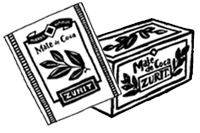
Coca and the Rural Economy
Coca is not cocaine

Coca bushes grow best in the mountain valleys of the Andes in South America. This green bush has been cultivated and used for thousands of years by Andean peoples, as a stimulant and for social and spiritual purposes. The traditional use of coca leaves continues in Andean countries, either chewed or as health-giving infusions and teas. Coca-leaf teabags are produced legally in Bolivia and Peru for local sale.
The United Nations has listed coca as a harmful substance which is illegal to export. There is no conclusive medical evidence about whether coca use is harmful, or beneficial. Cocaine is a different substance, chemically processed from coca leaves as an addictive drug which is harmful and dangerous. Even so, cocaine was used early in the twentieth century as a medicine in Europe.
An unfair trade
While the cultural and economic issues are complex, some people are barely surviving on coca cultivation while others are making huge profits on cocaine trade. Alternative development schemes in Andean farming communities have been successful reducing the production of coca leaves for export. Military intervention and aerial chemical spraying of crops have also been used. The development answers at the production end are not simple.
About 1.5 million people in Bolivia, Peru and Colombia are dependent on the production of coca leaves. Their choice becomes understandable when seen in comparison with the net farm income from other legal crops that can be produced in the same areas. Pineapple, black pepper, oranges, coffee, cocoa, bananas, maize crops would produce between 7.5% and 87% of the possible income from coca cultivation. Still, living standards in coca producing areas are extremely low.
Illicit drugs
Until recently Peru was the world's largest coca leaf producer. It has reduced the area of coca under cultivation by 26%, from 68,800 hectares in 1997 to 51,000 hectares at the end of 1998. Most of the cocaine base is shipped to neighbouring Colombia and Brazil for processing into cocaine for the international drug market, but exports of finished cocaine front Peru are increasing.
Source: CIA factbook 1999
Alternative development
"The objective here is to put in place the infrastructure that can enable peasants in drug producing countries to grow and sell legitimate crops. To be successful, alternative development needs to ensure that peasants have access to markets to sell their produce, and that they are protected by law enforcement agencies against the traffickers who will almost certainly resist efforts to turn peasants away from illicit drug crops. This type of programme has worked successfully in several regions around the world...notable successes in the coca-cultivating Andean countries. Production in Peru has fallen by 40% over the last two years".
Source: Tackling Drugs-The UK's International Strategy, Foreign and Commonwealth Office, 1998
The key development challenge is to provide a socio-economic base in order for peasant farmers to gain an improving livelihood from the production of legitimate cash crops. Landownership and rights to water supplies remain important issues. Policies for sustainable growth at this local level need to be consistent with regional and global factors. The Andean rural economy does not stand in isolation. Successful human development requires support for the poorest peoples, with sound health and education services for all.
